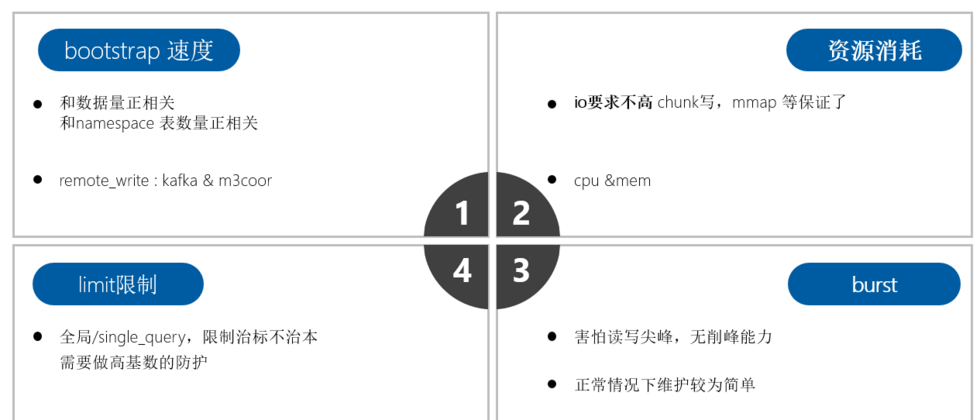视频教程
m3db资源开销问题:无需用ssd,也没必要做raid
正常情况下m3db 对io要求不高
- 因为和prometheus一样设计时采用了
mmap等技术,所以没必要采用ssd - 和open-falcon/夜莺等采用rrd不同,rrd 单指标单文件,很耗io
cpu和内存开销
写峰很危险,原因很简单
- 一条新的数据写入的时候,需要申请block,索引等一系列内存,伴随着cpu开销
- 但是如果没有新的数据,只是不断的写入点,那么只涉及到点的append追加,则开销较小
- 所以在突发的写峰对于tsdb来说就是危险,比如auto_scaling
- 最理想的情况就是100w条数据,都是平稳的没有变化的持续追加点写入
- 但是在容器中不现实,因为每次pod滚动都涉及 id等唯一值的变化
读峰也很危险,原因如下
- m3db默认内置lru会缓存查询的block等,这个为了一个典型的场景
- 就是一个dashboard查出来后点刷新时间,除了时间其他查询tag没变化,这种lru能应付的很好
- 但是对于高基数的查询来说,lru的意义就不大了
- 而且会涉及到读取放大的问题,假设1w基数需要100M内存,则100w基数需要10G内存
m3db bootstrap速度问题
- 在节点oom或其他原因导致的重启中,bootstrap速度决定了节点多久能提供服务
- bootstrap速度和
namespace 数量正相关,和数据量大小正相关 - 而且会优先提供写服务,避免长时间不能写入数据造成断点
- 而且再重启时 会有大量读盘操作,基本能把io打满(因为需要将磁盘中的部分数据缓存到内存中)
聚合说明
不要直接在m3coordinator 中开启聚合
- 我们知道直接在m3coordinator中配置
type: aggregated的namespace是可以直接开启聚合的 但是官方文档 说的很清楚了
The M3 Coordinator also performs this role but is not cluster aware. This means metrics will not get aggregated properly if you send metrics in round robin fashion to multiple M3 Coordinators for the same metrics ingestion source (e.g. Prometheus server).- 因为数据按照轮询模式打过来到m3coordinator上,导致同一个指标的不同时刻数据可能出现在多个m3coordinator上,聚合出来的结果就是错的
利用m3aggregator 做downsample
- 与M3DB相似m3aggregator,默认情况下支持集群和复制。
- 这意味着度量标准已正确路由到负责聚合每个度量标准的一个或多个实例
- 并且m3aggregator可以配置多个副本,以使聚合没有单点故障。
降采样原理
m3agg根据配置的resolution计算后推给m3coordinator回写m3db如下配置我们可以降采样的保存监控数据:注意 下面间隔和粒度都是根据grafana查询时间算的step推算出的
default表:不聚合保存30小时agg1表:5m为粒度保存96小时,即4天agg2表:20m为粒度保存360小时,即15天agg3表:60m为粒度保存360小时,即3个月
- namespace: default type: unaggregated retention: 30h - namespace: agg1 type: aggregated retention: 96h resolution: 5m - namespace: agg2 type: aggregated retention: 360h resolution: 20m - namespace: agg3 type: aggregated retention: 2160h resolution: 60m
降采样后多张表数据merge
- 数据在每张表中都会存在
- 依据不同的保存精度,agg会聚合写入结果
- 多张表查询的时候,每个时间段以最精确的为准,也就是说会
merge - 如果在查询端少配置了几张表,那么就是缺数据
利用聚合打到降采样的目的
- 减少存储需求
- 对于时间久的数据,以原始点存放其实意义很小,因为查询的时候都会以较粗的精度出图,比如 15天范围内可能就是1个小时一个点了
对于query的limit限制 ,这些限制都治标不治本,因为要看限制在多深的地方设置的
- 举个例子:查询需要5次内存申请,只有在第4层才能判定这个query是否打到上限,那么只是省了最后一次内存申请
- 这样就演变成了:每次都在很深的地方才限制住了,资源总是在浪费
- 如果能在第一层就限制住,如布隆过滤器直接告诉不存在,那么则可以避免后面几次资源开销
m3db limit
- 可以设置在一个回溯窗口内
lookback最大读取的时间序列数据的总量maxRecentlyQueriedSeriesBlocks - 这个配置代表在3秒内最多允许 21w的block查询(7w来自于m3db监控图中的block数据)
- maxOutstandingReadRequests 代表并发读请求数
maxRecentlyQueriedSeriesDiskRead可以设置读盘的限制
db: limits: maxRecentlyQueriedSeriesBlocks: value: 700000 lookback: 3s maxOutstandingWriteRequests: 0 maxOutstandingReadRequests: 0
保护m3db的正确姿势,是在前面prometheus查询的时候 识别并拦截高基数查询
m3db 读写一致性
在db高负载情况下,可以配置m3coordinator 读一致性为one 即
readConsistencyLevel: one,降低后端压力clusters: # Fill-out the following and un-comment before using, and # make sure indent by two spaces is applied. - namespaces: - namespace: default type: unaggregated retention: 30h client: config: service: env: default_env zone: embedded service: m3db cacheDir: /var/lib/m3kv etcdClusters: - zone: embedded endpoints: - xxx1:2379 - xxx2:2379 - xxx3:2379 writeConsistencyLevel: majority readConsistencyLevel: one
etcd操作
# 执行etcd host变量
ETCDCTL_API=3
HOST_1=xxx
HOST_2=xxx
HOST_3=xxx
ENDPOINTS=$HOST_1:2379,$HOST_2:2379,$HOST_3:2379
# 获取匹配字符串的key
etcdctl --endpoints=$ENDPOINTS get --prefix "" --keys-only=true
_kv/default_env/m3db.node.namespaces
_sd.placement/default_env/m3db
# 删除agg的placement
etcdctl --endpoints=$ENDPOINTS del /placement/namespace/m3db-cluster-name/m3aggregator
## 删除namespace
etcdctl --endpoints=$ENDPOINTS del _kv/default_env/m3db.node.namespaces
etcdctl --endpoints=$ENDPOINTS del _sd.placement/default_env/m3dbm3db dump火焰图
- 注意在高负载情况下dump的速度会很慢
第一步:请求m3db:7201/debug/dump接口,m3db代码中内置好了生成pprof信息的zip接口
#!/usr/bin/env bash
input_host_file=$1
output_dir=$2
for i in `cat $1`;do
curl -s $i:7201/debug/dump >${output_dir}/${i}_`date "+%Y_%m_%d_%H_%M_%S"`.zip &
done
第二步:解压zip文件,查看goroutine 执行情况
- 解压zip文件,可以得到cpu、heap、goroutine三个prof文件 和m3db的一些元信息
root@k8s-local-test-02:~/pprof$ ll
total 4060
-rw-r--r-- 1 root root 3473 Dec 31 1979 cpu.prof
-rw-r--r-- 1 root root 3953973 Dec 31 1979 goroutine.prof
-rw-r--r-- 1 root root 178938 Dec 31 1979 heap.prof
-rw-r--r-- 1 root root 40 Dec 31 1979 host.json
-rw-r--r-- 1 root root 592 Dec 31 1979 namespace.json
-rw-r--r-- 1 root root 5523 Dec 31 1979 placement-m3db.json
grep goroutine goroutine.prof | awk -F '[' '/goroutine \d*/{print "[" $2}' |sort | uniq -c | sort -k1nr | head -20
# 可以看到哪些goroutine最多
# 再根据详细的信息分析程序问题
16800 [select]:
9422 [chan receive, 40355 minutes]:
1911 [select, 2 minutes]:
631 [runnable]:
509 [IO wait]:
90 [chan receive, 40341 minutes]:
76 [chan receive]:
72 [semacquire]:
25 [select, 291 minutes]:
23 [sleep]:
17 [chan receive, 7205 minutes]:
17 [chan receive, 7402 minutes]:
14 [select, 4 minutes]:
12 [chan receive, 6120 minutes]:
10 [chan receive, 5577 minutes]:
5 [select, 165 minutes]:
4 [chan receive, 5176 minutes]:
4 [select, 40355 minutes]:
3 [chan receive, 7404 minutes]:
2 [IO wait, 40355 minutes]:
第三步: 利用火焰图分析工具分析程序内存和cpu性能
安装 graphviz工具
yum -y install graphviz根据prof文件生成svg图片,用浏览器打开svg图片即可查看
go tool pprof -svg cpu.prof > cpu.svg根据prof文件构建http访问查看
go tool pprof -http=localhost:8088 cpu.prof- 火焰图样例



**粗体** _斜体_ [链接](http://example.com) `代码` - 列表 > 引用。你还可以使用@来通知其他用户。